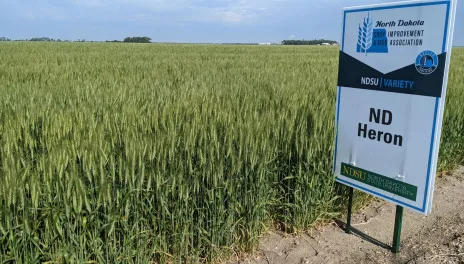A Team Effort: New NDSU Hard Red Spring Wheat Variety Development Takes Collaboration
It takes about 10 years to successfully release a new seed variety to farmers, says Andrew Green, NDSU spring wheat breeder. But it is not just the time it takes that makes a new variety successful, it’s the hundreds of steps it takes and the collaboration among plant breeders, scientists, agronomists, NDSU Research Extension Centers, Extension agents, seed distributors and farmers.
Recently released by NDSU, ND Heron is a new hard red spring wheat (HRSW) variety developed by the hard spring breeding program that is best suited for growing in western and central North Dakota. ND Heron was named after the water-loving bird because of its water-absorption capacity, which is an interesting end-use property for milling and baking.
“We have two customers in mind when we start breeding for a new seed variety,” says Green. “The first is the farmer that will grow it. So, we are selecting experimental lines based on straw strength, maturity date, test weight and grain yield, as well as resistance to disease.”
“The other customer is the end-user,” Green continues. “Hard red spring wheat from the northern Great Plains is known around the world for its excellent end-use quality.”
Millers and bakers consider many factors in determining the quality and value of wheat they purchase. Several key parameters are high test weight for optimum milling yield and flour color, high protein content and excellent protein quality for superior bread making.
Based on the years of trial data, ND Heron has shown to have a competitive yield package coupled with high test weight and protein. It has excellent end-use quality and good disease resistance to fusarium head blight, bacterial leaf streak and common rust races.
To help develop new varieties, NDSU’s Research Extension Centers are positioned across the state, and work with plant breeders and scientists to grow the experimental varieties and collaborate with the breeders on all parts of the process.
“Because of ND Heron’s suitability for central and western North Dakota, the North Central Research Extension Center (NCREC) at Minot, was selected as one of the locations where the variety would be grown and tested for six to seven years before its release,” says Shana Forster, NCREC director. “Part of our mission is to help screen potential varieties and ultimately produce foundation seed that benefits farmers in our region. RECs are part of the team effort in a collaborative that brings new ideas, education and products, such as seed, to the citizens we serve.”
“Our partners at the RECs don’t just grow variety trials for the plant breeders back on campus,” says Green. “They play an integral role in developing the land resources we need, scouting for pests and disease, collecting data, sharing feedback and making recommendations.”
Once a variety is selected to be released to the public, the NCREC is one of four RECs and the Agronomy Seed Farm in the state that grows foundation seed. The foundation seed is then distributed to certified farmers through the North Dakota County Crop Improvement Association seed increase program.
“We rely on our NDSU Extension agents to help administer the seed increase program,” says Forster. “Through an application process, farmers become qualified contract seed growers who produce certified seed. This allows for rapid increase and significant market penetration of improved varieties for North Dakota farmers.”
“When it comes to variety development, we are always trying to stay ahead, even if it is an 8-to-10-year process,” says Green. “Bacterial leaf streak disease, the wheat stem sawfly, yield potential when grown in acidic soils and improving straw strength are just a few of our focuses as we continue to develop new wheat varieties.”
FOR MORE INFORMATION:
NDSU Variety Trial Selection Tool
Andrew Green, 701-231-8478, andrew.j.green@ndsu.edu
Shana Forster, 701-857-7679, shana.forster@ndsu.edu

